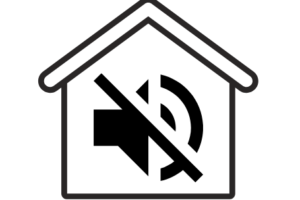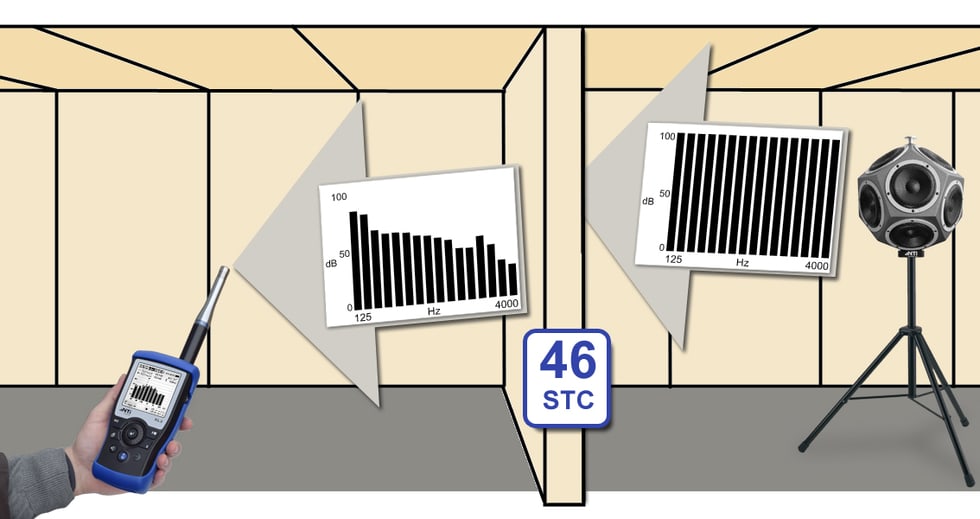If you’re new to soundproofing, you might be trying to wrap your head around what STC(Sound Transmission Class) is, how much it should be of your walls and floors, as well as any other surfaces inside your room.
I can tell you’re seriously looking to get your soundproofing done because of the fact that you’re asking this very question. That’s because knowing the optimal STC rating for whatever soundproofing solution you’re looking for is very important.
Here’s what I found out:
- For soundproof windows, you can expect a STC of about 45-48.
- For walls, the optimal STC for soundproofing such that you aren’t disturbed by LOUD music in the next room is about 60.
- For doors, STC 40 can be reasonably expected by doing some simple, inexpensive reinforcements. Pre-made doors with STC of around 50-55 are available too
- For nearly completely soundproof floors, the STC value is around 65-70.
There are a lot of other things to consider though- such as IIC(Impact Isolation Class), especially for flooring, as well the tradeoff between costs and STC.
Let me explain:
What Is A Good STC Rating For Soundproofing Walls?
STC rating for a proper soundproof wall is about 60. You’ll probably need to install two layers of drywall, along with a staggered stud construction and an insulating layer in between to achieve this.
Such a high STC might be overkill for you though- so it totally depends on your needs. If you just need to block out your flatmate’s loud voice, a STC of 50-55 will be fine- which is what most new homes are designed to follow in the US.
If you want to block out sounds of loud music in the next room though(or contain them inside yours) a STC closer to 60 is necessary.
What Is A Good STC Rating For Soundproofing Doors?
Generally doors will have a STC rating of about 20. This number is shockingly low because most commercial housing are made with hollow core doors to save costs.
You can take some simple steps, such as:
- Reinforce the door with some plywood
- Plug any gaps around the frame with sealant/ caulk
These quick wins will give you a noticeably quieter door and you can expect to increase the STC to about 35-36, if you do it properly.
If you want to go still higher, you’ll have to buy a specially made soundproof door. Usually, sound proof doors are available in the STC range of 35-50.
What Is A Good STC Rating For Soundproofing Windows?
A normal, single/double pane glass window will have a STC rating of 27-28.
A proper soundproof window will have STC rating in the range of 48-54. If it is a soundproof window over a double pane window, the STC will be slightly more but I don’t imagine it will be a huge difference
Again this might be too costly an option for some, and if you don’t want to spend close to ~800 Dollars just on a window and installation charges then you can also look at some other solution such as acoustic curtains and blocking any gaps in the window frame with sealant tape.
What Is A Good STC Rating For Soundproofing Floors?
For floors, a good STC and IIC(Impact Isolation Class) rating is about 60. If you want the best soundproofing, you’ll need something closer to a STC and IIC rating of 70.
This can be reasonably be achieved by using the right material for flooring along with some underlayment for added padding to the floor.
What Is STC?
| STC | Performance | Description |
| 50-60 | Excellent | Loud sounds heard faintly or not at all |
| 40-50 | Very Good | Loud speech heard faintly |
| 35-40 | Good | Loud speech heard but hardly intelligible |
| 30-35 | Fair | Loud speech understood fairly well |
| 25-30 | Poor | Normal speech understood easily and distinctly |
| 20-25 | Very Poor | Low speech audible |
Simply put, it is the way of measuring how effective a surface is at blocking sound. This is measured across mid to high frequencies BUT not for low frequencies- a major drawback that I’ll talk about in a bit.
Basically, you want your STC rating to be as high as possible. Higher the STC rating, more soundproof is that particular object.
A common misconception about STC is that if the value say, is 35 then it blocks 35 decibels of sound. The explanation why not is a bit technical:
How STC is actually calculated is you plot the loss of sound across the a large range of frequencies(125 Hz to ~4000Hz) and then compare it to the standard plots for various STC ratings. The STC of the plot yours is closest to becomes the STC rating for your object.
Another common misconception about STC is that it can be added- for instance, if two walls have STC rating of 30 and 40 respectively and if they are installed back to back next to each other, then the combined STC will NOT be 70.
This is because STC ratings are logarithmic values and cannot be added like simple numbers. Roughly speaking, the wall’s STC will be closer to 31-32.
Is There a minimum limit on STC?
The minimum limit on STC and IIC is 50 according to the new building code in the US. If you have an older house though, you will have to get your home tested to know how soundproof it is.
Also- even if you are living in a new building or condo, the rules still might not have been followed. This is because all community building inspection departments don’t require field testing of STC and IIC values- unfortunately, most just go by the architectural specifications and trust that they will hold true on the ground.
What Is IIC?
IIC is Impact isolation class. It literally is like STC- only for impact sounds like footsteps, dropping objects, etc. This is why I said earlier that IIC should be a consideration mainly for soundproofing floors. No one in the next room is really going to have an issue with you walking ‘loudly’. It’s always going to be those living on the floor beneath yours.
Conclusion
STC is a really important metric- but remember that it isn’t appropriate for low frequencies!
Low frequencies, such as the sound of a bass drum are what carry the most and are the most annoying in homes- however, STC values are only calculated for mid to high range frequencies.
Adding mass to the wall, via multiple layers of drywall, say, along-with some insulating material such as MLV will help block low frequencies.
Another thing you’ll need to discuss with your contractor is increasing the depth of cavities in the wall. This adds more air which adds more mass- however it isn’t as helpful as adding an insulating layer, of course. You’ll have to balance your budget in order to take a call on this.
Finally, do remember that these are lab reported numbers and should be taken as guidelines instead of absolute numbers.The actual performance of a STC 55 material, say, will vary based on how it is installed.
This is why soundproofing a room should be looked at holistically. Installing the correct materials, but in an improper manner will not give desired results at all.


